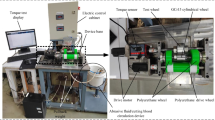Abstract
The size of particles of magnetic-abrasive powders, magnetic induction in the working zones of magnetic gaps, and the size of working zones have been studied for their effect on tangential and normal stresses which develop in magnetic-abrasive tools during polishing. Friction coefficients for the powder in magneticabrasive tools and in a tool—titanium pair are determined.
Similar content being viewed by others
References
Yu. M. Baron, Magnetic-Abrasive and Magnetic Treatment of Articles and Cutting Tools [in Russian], Mashinostroenie, Leningrad (1986).
V. E. Oliker, Powders for Magnetic-Abrasive Treatment and Wear-Resistant Coatings [in Russian], Metallurgiya, Moscow (1990).
M. D. Krymskii, “Formation of a powder magnetic-abrasive tool. I. Shape restorability,” Poroshk. Metall., No. 9, 8–12 (1987).
Yu. M. Baron and E. M. Zheltobryukhov, “Friction of magnetic-abrasive powders: internal and in contact with metal surfaces,” Dep. in VNIITEMR, No. 235 Msh, Leningrad (1985).
M. D. Krymskii, “Distribution and compaction of magnetic-abrasive powder in the working gap of a machine tool,” in: Magnetic-Abrasive Materials and Methods for Testing Them [in Russian], Institute of Materials Science Problems, Ukrainian Academy of Sciences, Kiev (1980), pp. 92–97.
V. S. Maiboroda and V. Ya. Shlyuko, “Features of the movement of ferromagnetic powder in magnetic-abrasive treatment,” Poroshk. Metall., No. 8, 3–8 (1987).
O. V. Stepanov, V. S. Maiboroda, V. Ya. Shlyuko, and A. N. Nechiporenko, “Features of powder movement with magnetic-abrasive treatment under conditions of annular arrangement of magnetic gaps,” in: Technology and Organization of Production [in Russian], No. 4, Dep. in UkrNIINTI, No. 1493-Uk (1988).
V. S. Maiboroda, V. Ya. Shlyuko, and T. Ya. Gridasova, “Features of powder movement in magnetic-abrasive polishing of small articles of complex shape,” Poroshk. Metall., No. 7, 90–95 (1985).
V. I. Zhdanovich, “Study of magnetic-abrasive treatment of outer cylindrical surfaces,” Author's Abstr. Diss. Cand. Tech. Sci., Minsk (1974).
V. S. Maiboroda, O. V. Stepanov, and V. Ya. Shlyuko, “Study of magnetic-abrasive treatment conditions with an annular arrangement of magnetic gaps,” Tekh. Avtomat. Mashinostr., No. 42, 74–79 (1988).
V. S. Maiboroda, V. Ya. Shlyuko, N. L. Taranenko, and O. V. Stepanov, “Study of the electrical resistivity of a powder magnetic-abrasive tool,” Poroshk. Metall., No. 4, 83–87 (1992).
Additional information
Kiev Polytechnic Institute. Translated from Poroshkovaya Metallurgiya, Nos. 1–2, pp. 62–66, January–February, 1994.
Rights and permissions
About this article
Cite this article
Maiboroda, V.S., Stepanov, O.V., Taranenko, N.L. et al. Rheological characteristics of magnetic-abrasive powders in a magnetic field. Powder Metall Met Ceram 33, 57–60 (1995). https://doi.org/10.1007/BF00559710
Received:
Issue Date:
DOI: https://doi.org/10.1007/BF00559710




